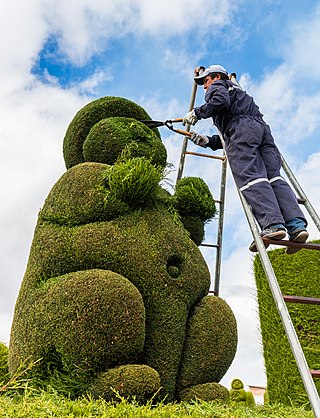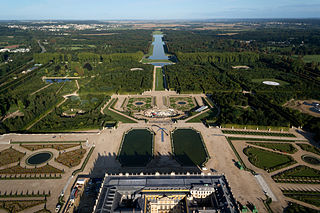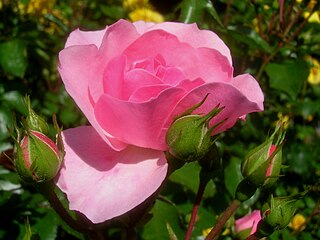
A garden is a planned space, usually outdoors, set aside for the cultivation, display, and enjoyment of plants and other forms of nature. The single feature identifying even the wildest wild garden is control. The garden can incorporate both natural and artificial materials.

Topiary is the horticultural practice of training perennial plants by clipping the foliage and twigs of trees, shrubs and subshrubs to develop and maintain clearly defined shapes, whether geometric or fanciful. The term also refers to plants which have been shaped in this way. As an art form it is a type of living sculpture. The word derives from the Latin word for an ornamental landscape gardener, topiarius, a creator of topia or "places", a Greek word that Romans also applied to fictive indoor landscapes executed in fresco.

A parterre is a part of a formal garden constructed on a level substrate, consisting of symmetrical patterns, made up by plant beds, plats, low hedges or coloured gravels, which are separated and connected by paths. Typically it was the part of the garden nearest the house, perhaps after a terrace. The view of a parterre from inside the house, especially from the upper floors, was a major consideration in its design. The word "parterre" was and is used both for the whole part of the garden containing parterres and for each individual section between the "alleys".
Garden design is the art and process of designing and creating plans for layout and planting of gardens and landscapes. Garden design may be done by the garden owner themselves, or by professionals of varying levels of experience and expertise. Most professional garden designers have some training in horticulture and the principles of design. Some are also landscape architects, a more formal level of training that usually requires an advanced degree and often a state license. Amateur gardeners may also attain a high level of experience from extensive hours working in their own gardens, through casual study, serious study in Master gardener programs, or by joining gardening clubs.

Charles Bridgeman (1690–1738) was an English garden designer who helped pioneer the naturalistic landscape style. Although he was a key figure in the transition of English garden design from the Anglo-Dutch formality of patterned parterres and avenues to a freer style that incorporated formal, structural and wilderness elements, Bridgeman's innovations in English landscape architecture have been somewhat eclipsed by the work of his more famous successors, William Kent and Lancelot "Capability" Brown.

The cottage garden is a distinct style that uses informal design, traditional materials, dense plantings, and a mixture of ornamental and edible plants. English in origin, it depends on grace and charm rather than grandeur and formal structure. Homely and functional gardens connected to cottages go back centuries, but their stylized reinvention occurred in 1870s England, as a reaction to the more structured, rigorously maintained estate gardens with their formal designs and mass plantings of greenhouse annuals.

The English landscape garden, also called English landscape park or simply the English garden, is a style of "landscape" garden which emerged in England in the early 18th century, and spread across Europe, replacing the more formal, symmetrical French formal garden which had emerged in the 17th century as the principal gardening style of Europe. The English garden presented an idealized view of nature. Created and pioneered by William Kent and others, the "informal" garden style originated as a revolt against the architectural garden and drew inspiration from paintings of landscapes by Salvator Rosa, Claude Lorrain, and Nicolas Poussin.

The traditional kitchen garden, vegetable garden, also known as a potager or in Scotland a kailyaird, is a space separate from the rest of the residential garden – the ornamental plants and lawn areas. It is used for growing edible plants and often some medicinal plants, especially historically. The plants are grown for domestic use; though some seasonal surpluses are given away or sold, a commercial operation growing a variety of vegetables is more commonly termed a market garden. The kitchen garden is different not only in its history, but also its functional design. It differs from an allotment in that a kitchen garden is on private land attached or very close to the dwelling. It is regarded as essential that the kitchen garden could be quickly accessed by the cook.

Westbury Court Garden is a Dutch water garden in Westbury-on-Severn, Gloucestershire, England, 9 miles (14 km) southwest of Gloucester. It is a rare survival of seventeenth century garden design and was initially laid out by the owner of Westbury Court, Maynard Colchester I, in 1696–1705. The garden has been under the guardianship of the National Trust since 1967.

Stephen Switzer (1682–1745) was an English gardener, garden designer and writer on garden subjects, often credited as an early exponent of the English landscape garden. He is most notable for his views of the transition between the large garden, still very formal in his writings, and the surrounding countryside, especially woodland.

In gardening, a garden room is a secluded and partly enclosed space within a garden that creates a room-like effect. Such spaces have been part of garden design for centuries. Generally they are regarded as different from terraces and patios just outside a building, although in practice these are often the parts of a garden that are most used as a room, with tables and chairs. Walls and hedges may form part of the boundaries of a garden room, but plants, usually at least a few feet tall, will do as well. Apart from the entrances to the room, these should normally enclose the space. There may be furniture, especially for sitting down, but this is not essential.

The French formal garden, also called the jardin à la française, is a style of "landscape" garden based on symmetry and the principle of imposing order on nature. Its epitome is generally considered to be the Gardens of Versailles designed during the 17th century by the landscape architect André Le Nôtre for Louis XIV and widely copied by other European courts.

Garden roses are predominantly hybrid roses that are grown as ornamental plants in private or public gardens. They are one of the most popular and widely cultivated groups of flowering plants, especially in temperate climates. An enormous number of garden cultivars have been produced, especially over the last two centuries, though roses have been known in the garden for millennia beforehand. While most garden roses are grown for their flowers, often in dedicated rose gardens, some are also valued for other reasons, such as having ornamental fruit, providing ground cover, or for hedging.

The Baroque garden was a style of garden based upon symmetry and the principle of imposing order on nature. The style originated in the late-16th century in Italy, in the gardens of the Vatican and the Villa Borghese gardens in Rome and in the gardens of the Villa d'Este in Tivoli, and then spread to France, where it became known as the jardin à la française or French formal garden. The grandest example is found in the Gardens of Versailles designed during the 17th century by the landscape architect André Le Nôtre for Louis XIV. In the 18th century, in imitation of Versailles, very ornate Baroque gardens were built in other parts of Europe, including Germany, Austria, Spain, and in Saint-Petersburg, Russia. In the mid-18th century the style was replaced by the less geometric and more natural English landscape garden.

A formal garden is a garden with a clear structure, geometric shapes and in most cases a symmetrical layout. Its origin goes back to the gardens which are located in the desert areas of Western Asia and are protected by walls. The style of a formal garden is reflected in the Persian gardens of Iran, and the monastic gardens from the Late Middle Ages. It has found its continuation in the Italian Renaissance gardens and has culminated in the French formal gardens from the Baroque period. Through its design, the garden conveys a sense of established order and transparency to the observer.

Rosa 'Bonica 82',, is a shrub rose cultivar, bred by Marie-Louise Meilland in France in 1982. The cultivar was named an All-America Rose Selections winner in 1987.

Writing about gardens takes a variety of literary forms, ranging from instructional manuals on horticulture and garden design, to essays on gardening, to novels. Garden writing has been published in English since at least the 16th century.

In the Western history of gardening, from the 16th to early 19th centuries, a wilderness was a highly artificial and formalized type of woodland, forming a section of a large garden. Though examples varied greatly, a typical English style was a number of geometrically-arranged compartments closed round by hedges, each compartment planted inside with relatively small trees. Between the compartments there were wide walkways or "alleys", usually of grass, sometimes of gravel. The wilderness provided shade in hot weather, and relative privacy. Though often said by garden writers at the time to be intended for meditation and reading, the wilderness was much used for walking, and often flirtation. There were few if any flowers, but there might be statues, and some seating, especially in garden rooms or salle vertes, clearings left empty. Some had other features, such as a garden maze.

In the history of gardening and landscaping, a canal is a relatively large piece of water that has a very regular shape, usually long, thin and rectangular. The peak period for garden canals was the 17th and 18th centuries, by the end of which less formal water features were in favour, in the style of the English landscape garden. It is distinguished from a garden pond or lake by its shape, and typically falls somewhere between the two in area. It might be wholly artificial, created by diverting and damming a stream, or based around a natural water feature which is landscaped. Usually it appears to be enclosed, though in fact water passes in and out by channels below the surface. The edges are often walled, and the water relatively shallow.

A woodland garden is a garden or section of a garden that includes large trees and is laid out so as to appear as more or less natural woodland, though it is often actually an artificial creation. Typically it includes plantings of flowering shrubs and other garden plants, especially near the paths through it.





























